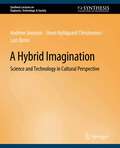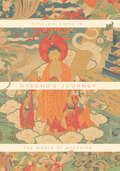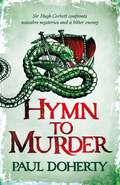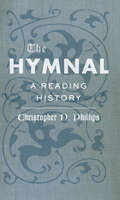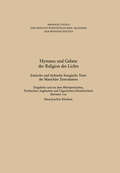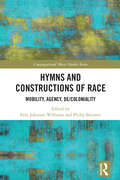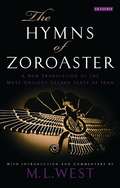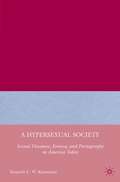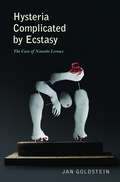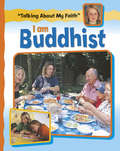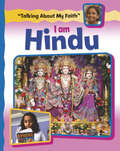- Table View
- List View
Hybrid Hate: Conflations of Antisemitism & Anti-Black Racism from the Renaissance to the Third Reich
by Tudor ParfittHybrid Hate is the first book to study the conflation of antisemitism and anti-Black racism. As objects of racism, Jews and Blacks have been linked together for centuries as peoples apart from the general run of humanity. In this book, Tudor Parfitt investigates the development of antisemitism, anti-Black racism, and race theory in the West from the Renaissance to the Second World War. Parfitt explains how Jews were often perceived as Black in medieval Europe, and the conflation of Jews and Blacks continued throughout the period of the Enlightenment. With the discovery of a community of Black Jews in Loango in West Africa in 1777, and later of Black Jews in India, the Middle East, and other parts of Africa, the notion of multiracial Jews was born. Over the following centuries, the figure of the hybrid Black Jew was drawn into the maelstrom of evolving theories about race hierarchies and taxonomies. Parfitt analyses how Jews and Blacks were increasingly conflated in a racist discourse from the mid-nineteenth century to the period of the Third Reich, as the two fundamental prejudices of the West were combined. Hybrid Hate offers a new interpretation of the rise of antisemitism and anti-Black racism in Europe, and casts light on contemporary racist discourses in the United States and Europe.
A Hybrid Imagination: Technology in Historical Perspective (Synthesis Lectures on Engineers, Technology, & Society)
by Andrew Jamison Steen Hyldgaard Christensen Lars BotinThis book presents a cultural perspective on scientific and technological development. As opposed to the "story-lines" of economic innovation and social construction that tend to dominate both the popular and scholarly literature on science, technology and society (or STS), the authors offer an alternative approach, devoting special attention to the role played by social and cultural movements in the making of science and technology. They show how social and cultural movements, from the Renaissance of the late 15th century to the environmental and global justice movements of our time, have provided contexts, or sites, for mixing scientific knowledge and technical skills from different fields and social domains into new combinations, thus fostering what the authors term a "hybrid imagination." Such a hybrid imagination is especially important today, as a way to counter the competitive and commercial "hubris" that is so much taken for granted in contemporary science and engineering discourses and practices with a sense of cooperation and social responsibility. The book portrays the history of science and technology as an underlying tension between hubris -- literally the ambition to "play god" on the part of many a scientist and engineer and neglect the consequences - and a hybrid imagination, connecting scientific "facts" and technological "artifacts" with cultural understanding. The book concludes with chapters on the recent transformations in the modes of scientific and technological production since the Second World War and the contending approaches to "greening" science and technology in relation to the global quest for sustainable development. The book is based on a series of lectures that were given by Andrew Jamison at the Technical University of Denmark in 2010 and draws on the authors' many years of experience in teaching non-technical, or contextual knowledge, to science and engineering students. The book has been written as part of the Program of Research on Opportunities and Challenges in Engineering Education in Denmark (PROCEED) supported by the Danish Strategic Research Council from 2010 to 2013. Table of Contents: Introduction / Perceptions of Science and Technology / Where Did Science and Technology Come From? / Science, Technology and Industrialization / Science, Technology and Modernization / Science, Technology and Globalization / The Greening of Science and Technology
Hybride Events: Zur Diskussion zeitgeistiger Veranstaltungen (Erlebniswelten)
by Gregor J. Betz Ronald Hitzler Arne Niederbacher Lisa SchäferSchnippeldiskos, Kopfhörerpartys, BarCamps, Star Wars-Gottesdienste: Als Hybride Events bezeichnen wir solche inszenierten Ereignisse, die aus augenfälligen Kombinationen mindestens zweier Arten von Ereignissen bestehen, die als verschiedenen kulturellen Bereichen zugehörig angesehen werden (z.B. Fest und Feier, Ernst und Spaß, Information und Unterhaltung, Action und Comedy, Wissenschaft und Sport usw.). In dem Band untersuchen Wissenschaftlerinnen und Wissenschaftler unterschiedlicher geisteswissenschaftlicher Disziplinen Fallbeispiele solcher Ereignisse, versuchen diese theoretisch zu fassen und gesellschaftsdiagnostisch auszuwerten.
Hyecho's Journey: The World of Buddhism
by Donald S. Lopez Jr.In the year 721, a young Buddhist monk named Hyecho set out from the kingdom of Silla, on the Korean peninsula, on what would become one of the most extraordinary journeys in history. Sailing first to China, Hyecho continued to what is today Vietnam, Indonesia, Myanmar, India, Pakistan, Afghanistan, and Iran, before taking the Silk Road and heading back east, where he ended his days on the sacred mountain of Wutaishan in China. With Hyecho’s Journey, eminent scholar of Buddhism Donald S. Lopez Jr. re-creates Hyecho’s trek. Using the surviving fragments of Hyecho’s travel memoir, along with numerous other textual and visual sources, Lopez imagines the thriving Buddhist world the monk explored. Along the way, Lopez introduces key elements of Buddhism, including its basic doctrines, monastic institutions, works of art, and the many stories that have inspired Buddhist pilgrimage. Through the eyes of one remarkable Korean monk, we discover a vibrant tradition flourishing across a vast stretch of Asia. Hyecho’s Journey is simultaneously a rediscovery of a forgotten pilgrim, an accessible primer on Buddhist history and doctrine, and a gripping, beautifully illustrated account of travel in a world long lost.
Hyecho's Journey: The World of Buddhism
by Donald S. Lopez Jr.In the year 721, a young Buddhist monk named Hyecho set out from the kingdom of Silla, on the Korean peninsula, on what would become one of the most extraordinary journeys in history. Sailing first to China, Hyecho continued to what is today Vietnam, Indonesia, Myanmar, India, Pakistan, Afghanistan, and Iran, before taking the Silk Road and heading back east, where he ended his days on the sacred mountain of Wutaishan in China. With Hyecho’s Journey, eminent scholar of Buddhism Donald S. Lopez Jr. re-creates Hyecho’s trek. Using the surviving fragments of Hyecho’s travel memoir, along with numerous other textual and visual sources, Lopez imagines the thriving Buddhist world the monk explored. Along the way, Lopez introduces key elements of Buddhism, including its basic doctrines, monastic institutions, works of art, and the many stories that have inspired Buddhist pilgrimage. Through the eyes of one remarkable Korean monk, we discover a vibrant tradition flourishing across a vast stretch of Asia. Hyecho’s Journey is simultaneously a rediscovery of a forgotten pilgrim, an accessible primer on Buddhist history and doctrine, and a gripping, beautifully illustrated account of travel in a world long lost.
Hyecho's Journey: The World of Buddhism
by Donald S. Lopez Jr.In the year 721, a young Buddhist monk named Hyecho set out from the kingdom of Silla, on the Korean peninsula, on what would become one of the most extraordinary journeys in history. Sailing first to China, Hyecho continued to what is today Vietnam, Indonesia, Myanmar, India, Pakistan, Afghanistan, and Iran, before taking the Silk Road and heading back east, where he ended his days on the sacred mountain of Wutaishan in China. With Hyecho’s Journey, eminent scholar of Buddhism Donald S. Lopez Jr. re-creates Hyecho’s trek. Using the surviving fragments of Hyecho’s travel memoir, along with numerous other textual and visual sources, Lopez imagines the thriving Buddhist world the monk explored. Along the way, Lopez introduces key elements of Buddhism, including its basic doctrines, monastic institutions, works of art, and the many stories that have inspired Buddhist pilgrimage. Through the eyes of one remarkable Korean monk, we discover a vibrant tradition flourishing across a vast stretch of Asia. Hyecho’s Journey is simultaneously a rediscovery of a forgotten pilgrim, an accessible primer on Buddhist history and doctrine, and a gripping, beautifully illustrated account of travel in a world long lost.
Hyecho's Journey: The World of Buddhism
by Donald S. Lopez Jr.In the year 721, a young Buddhist monk named Hyecho set out from the kingdom of Silla, on the Korean peninsula, on what would become one of the most extraordinary journeys in history. Sailing first to China, Hyecho continued to what is today Vietnam, Indonesia, Myanmar, India, Pakistan, Afghanistan, and Iran, before taking the Silk Road and heading back east, where he ended his days on the sacred mountain of Wutaishan in China. With Hyecho’s Journey, eminent scholar of Buddhism Donald S. Lopez Jr. re-creates Hyecho’s trek. Using the surviving fragments of Hyecho’s travel memoir, along with numerous other textual and visual sources, Lopez imagines the thriving Buddhist world the monk explored. Along the way, Lopez introduces key elements of Buddhism, including its basic doctrines, monastic institutions, works of art, and the many stories that have inspired Buddhist pilgrimage. Through the eyes of one remarkable Korean monk, we discover a vibrant tradition flourishing across a vast stretch of Asia. Hyecho’s Journey is simultaneously a rediscovery of a forgotten pilgrim, an accessible primer on Buddhist history and doctrine, and a gripping, beautifully illustrated account of travel in a world long lost.
Hymn to Murder: The Carpenter's Tale Of Mystery And Murder As He Goes On A Pilgrimage From London To Canterbury (Canterbury Tales Of Mystery And Murder Ser. #Vol. 5)
by Paul DohertyHugh Corbett returns in the twenty-first gripping mystery in Paul Doherty's ever-popular series. If you love the historical mysteries of C. J. Sansom, E. M. Powell and Bernard Cornwell you will love this.Secrets simmer in the lonely wasteland of Dartmoor.Spring, 1312. At Malmaison Manor, Lord Simon is concealing a dark secret - one he arrogantly assumes will never catch up with him. But someone knows about the crime he committed and they've found a way to make him pay. And he's not alone. When he is found mysteriously slain, other deaths soon follow. Meanwhile, ships on the Devonshire coast are being deliberately wrecked, their crews slaughtered, their cargoes plundered.Sir Hugh Corbett and Lord Simon are bound by the Secret Chancery and their search for one precious ruby - the Lacrima Christi. So, when Corbett learns of Lord Simon's death, he is once more dragged into a tangled web of lies and intrigue and it's not long before secrets of his own start to surface. As the Hymn to Murder reaches its crescendo, can Corbett confront his past and live to see another day?Praise for Paul Doherty's dark and suspenseful novels: 'His fascination for history comes off the page' Daily Express 'An opulent banquet to satisfy the most murderous appetite' Northern Echo 'Deliciously suspenseful, gorgeously written and atmospheric' Historical Novels Review 'Paul Doherty has a lively sense of history . . . evocative and lyrical descriptions' New Statesmen
The Hymnal: A Reading History
by Christopher N. PhillipsIt stands barely three inches high, a small brick of a book. The pages are skewed a bit, and evidence of a small handprint remains on the worn, cheap leather covers that don;€™t quite close. The book bears the marks of considerable use. But why;¢;‚¬;€?and for whom;¢;‚¬;€?was it made? Christopher N. Phillips;€™s The Hymnal is the first study to reconstruct the practices of reading and using hymnals, which were virtually everywhere in the eighteenth and nineteenth centuries. Isaac Watts invented a small, words-only hymnal at the dawn of the eighteenth century. For the next two hundred years, such hymnals were their owners;€™ constant companions at home, school, church, and in between. They were children's first books, slaves;€™ treasured heirlooms, and sources of devotional reading for much of the English-speaking world. Hymnals helped many people learn to memorize poetry and to read; they provided space to record family memories, pass notes in church, and carry everything from railroad tickets to holy cards to business letters. In communities as diverse as African Methodists, Reform Jews, Presbyterians, Methodists, Roman Catholics, and Unitarians, hymnals were integral to religious and literate life. An extended historical treatment of the hymn as a read text and media form, rather than a source used solely for singing, this book traces the lives people lived with hymnals, from obscure schoolchildren to Emily Dickinson. Readers will discover a wealth of connections between reading, education, poetry, and religion in Phillips;€™s lively accounts of hymnals and their readers.
The Hymnal: A Reading History
by Christopher N. PhillipsIt stands barely three inches high, a small brick of a book. The pages are skewed a bit, and evidence of a small handprint remains on the worn, cheap leather covers that don;€™t quite close. The book bears the marks of considerable use. But why;¢;‚¬;€?and for whom;¢;‚¬;€?was it made? Christopher N. Phillips;€™s The Hymnal is the first study to reconstruct the practices of reading and using hymnals, which were virtually everywhere in the eighteenth and nineteenth centuries. Isaac Watts invented a small, words-only hymnal at the dawn of the eighteenth century. For the next two hundred years, such hymnals were their owners;€™ constant companions at home, school, church, and in between. They were children's first books, slaves;€™ treasured heirlooms, and sources of devotional reading for much of the English-speaking world. Hymnals helped many people learn to memorize poetry and to read; they provided space to record family memories, pass notes in church, and carry everything from railroad tickets to holy cards to business letters. In communities as diverse as African Methodists, Reform Jews, Presbyterians, Methodists, Roman Catholics, and Unitarians, hymnals were integral to religious and literate life. An extended historical treatment of the hymn as a read text and media form, rather than a source used solely for singing, this book traces the lives people lived with hymnals, from obscure schoolchildren to Emily Dickinson. Readers will discover a wealth of connections between reading, education, poetry, and religion in Phillips;€™s lively accounts of hymnals and their readers.
Hymnen und Gebete der Religion des Lichts: Iranische und türkische liturgische Texte der Manichäer Zentralasiens (Abhandlungen der Rheinisch-Westfälischen Akademie der Wissenschaften)
by Hans-Joachim KlimkeitDie hier vorgelegten Hymnen und Gebete der Manichäer Zentralasiens sind Neubearbeitungen jener gnostischen Texte, die von den vier Preußischen "Turfan Expeditionen " zwischen 1902 und 1914 vornehmlich in der Oase T urfan am nörd lichen Rand der Taklamakan-Wüste gefunden und von diversen Wissenschaftlern seit 1904 bearbeitet wurden. Hinzu kommen einige von Sir AUREL STEIN und PAUL PELLIOT in Tun-huang geborgene türkisch-manichäische Texte. Die Preußische Akademie der Wissenschaften zu Berlin machte es sich in den ersten Jahrzehnten dieses Jahrhunderts zur besonderen Aufgabe, die neugefundenen manichäischen Texte, auf deren allgemeine Bedeutung kein geringerer als der Theologe RUDoLF BULTMANN verweisen sollte, zu erschließen. Ist diese Arbeit, die bereits 1904 durch die ersten Publikationen von F. W. K. MÜLLER eingeleitet wurde, vornehmlich in den zwanziger und dreißiger Jahren vorangetrieben worden, wobei Iranisten wie F. C. ANDREAS, W. B. HENNING und W. LENTZ (in Verbindung mit E. W ALDSCHMIDT) und Turkologen wie A. VON LE COQ, W. BANG und A. VON GABAIN maßgeblich be teiligt waren, so war doch angesichts des Fortschritts der Iranistik und Turkologie, zu dem teils diese Wissenschaftler und ihre Schüler selbst beigetragen haben, eine Neubearbeitung der teilweise vor mehr als sechzig Jahren übersetzten Texte not wendig.
Hymns and Constructions of Race: Mobility, Agency, De/Coloniality (Congregational Music Studies Series)
by Erin Johnson-Williams Philip BurnettHymns and Constructions of Race: Mobility, Agency, De/Coloniality examines how the hymn, historically and today, has reinforced, negotiated, and resisted constructions of race. It brings together diverse perspectives from musicology, ethnomusicology, theology, anthropology, performance studies, history, and postcolonial scholarship to show how the hymn has perpetuated, generated, and challenged racial identities. The global range of contributors cover a variety of historical and geographical contexts, with case studies from China and Brazil to Suriname and South Africa. They explore the hymn as a product of imperialism and settler colonialism and as a vehicle for sonic oppression and/or resistance, within and beyond congregational settings. The volume contends that the lived tradition of hymn-singing, with its connections to centuries of global Christian mission, is a particularly apt lens for examining both local and global negotiations of race, power, and identity. It will be relevant for scholars interested in religion, music, race, and postcolonialism.
Hymns and Constructions of Race: Mobility, Agency, De/Coloniality (Congregational Music Studies Series)
by Erin Johnson-Williams Philip BurnettHymns and Constructions of Race: Mobility, Agency, De/Coloniality examines how the hymn, historically and today, has reinforced, negotiated, and resisted constructions of race. It brings together diverse perspectives from musicology, ethnomusicology, theology, anthropology, performance studies, history, and postcolonial scholarship to show how the hymn has perpetuated, generated, and challenged racial identities. The global range of contributors cover a variety of historical and geographical contexts, with case studies from China and Brazil to Suriname and South Africa. They explore the hymn as a product of imperialism and settler colonialism and as a vehicle for sonic oppression and/or resistance, within and beyond congregational settings. The volume contends that the lived tradition of hymn-singing, with its connections to centuries of global Christian mission, is a particularly apt lens for examining both local and global negotiations of race, power, and identity. It will be relevant for scholars interested in religion, music, race, and postcolonialism.
The Hymns of Luke's Infancy Narratives: Their Origin, Meaning and Significance (Bloomsbury Academic Collections: Biblical Studies)
by Stephen FarrisThese hymns, the Magnificat, Benedictus and Nunc Dimittis, are a familiar part of Christian liturgy; but their origin is uncertain, their meaning debated and their significance within Luke-Acts often ignored. This monograph argues that they were composed in Hebrew by Jewish-Christian poets, and were incorporated by the evangelist as anticipating certain key themes of his own work.
The Hymns of Zoroaster: A New Translation of the Most Ancient Sacred Texts of Iran
by M. L. WestZoroaster was one of the greatest and most radical religious reformers in the history of the world. The faith that he founded some 2600 years ago in a remote region of central Asia flourished to become the bedrock of a great empire as well as its official religion. Zoroastrianism is still practised today in parts of India and Iran and in smaller communities elsewhere, where its adherents are known as Parsis. It has the distinction of being one of the most ancient religions in the world: only Hinduism can lay claim to greater antiquity. The foundation texts of this venerable system of belief are the founder's own passionate poems, known as the Gathas ('Songs'), and a short ritual composed soon after his death, called the Liturgy in Seven Chapters. These hymns are the authentic utterances of a religious leader whose thought was way ahead of his time, and are among the most precious relics of human civilization. After so many millennia they continue to speak to us of an impressively austere theology and of an inspiring and easily understood moral code. Yet existing translations are few, divergent in their interpretations of the original Avestan language of Zoroaster, and frequently hard to access. M L West's new translation, based on the best modern scholarship, and augmented by a substantial introduction and notes, makes these powerfully resonant texts available to a wide audience in clear and accessible form.'A thoroughly worthwhile and refreshingly readable translation of the Older Avesta, M L West's book will be widely welcomed, by students and general readers alike.'- Almut Hintze, Zartoshty Reader in Zoroastrianism, School of Oriental and African Studies, London
The Hyper(in)visible Fat Woman: Weight and Gender Discourse in Contemporary Society
by J. GaileyIn The Hyper(in)visible Fat Woman Gailey investigates the interface between fat women's perceptions of their bodies and of the social expectations and judgments placed on them. The book explores the phenomenon of 'hyper(in)visibility', the seemingly paradoxical social position of being paid exceptional attention while simultaneously being erased.
A Hypersexual Society: Sexual Discourse, Erotica, and Pornography in America Today
by K. KammeyerAs many can attest, the prevalence of sexual imagery has increased in modern society over the past half century. In this timely new study, Kenneth Kammeyer traces the historical development of sexual imagery in America and society's preoccupation with it, all within a firm theoretical and sociological framework.
Hysteria Complicated by Ecstasy: The Case of Nanette Leroux
by Jan GoldsteinHysteria Complicated by Ecstasy offers a rare window into the inner life of a person ordinarily inaccessible to historians: a semiliterate peasant girl who lived almost two centuries ago, in the aftermath of the French Revolution. Eighteen-year-old Nanette Leroux fell ill in 1822 with a variety of incapacitating nervous symptoms. Living near the spa at Aix-les-Bains, she became the charity patient of its medical director, Antoine Despine, who treated her with hydrotherapy and animal magnetism, as hypnosis was then called. Jan Goldstein translates, and provides a substantial introduction to, the previously unpublished manuscript recounting Nanette's strange illness--a manuscript coauthored by Despine and Alexandre Bertrand, the Paris physician who memorably diagnosed Nanette as suffering from "hysteria complicated by ecstasy." While hysteria would become a fashionable disease among urban women by the end of the nineteenth century, the case of Nanette Leroux differs sharply from this pattern in its early date and rural setting. Filled with intimate details about Nanette's behavior and extensive quotations of her utterances, the case is noteworthy for the sexual references that contemporaries did not recognize as such; for its focus on the difference between biological and social time; and for Nanette's fascination with the commodities available in the region's nascent marketplace. Goldstein's introduction brilliantly situates the text in its multiple contexts, examines it from the standpoint of early nineteenth-century medicine, and uses the insights of Foucault and Freud to craft a twenty-first-century interpretation. A compelling, multilayered account of one young woman's mental afflictions, Hysteria Complicated by Ecstasy is an extraordinary addition to the cultural and social history of psychiatry and medicine.
Hysteria Complicated by Ecstasy: The Case of Nanette Leroux
by Jan GoldsteinHysteria Complicated by Ecstasy offers a rare window into the inner life of a person ordinarily inaccessible to historians: a semiliterate peasant girl who lived almost two centuries ago, in the aftermath of the French Revolution. Eighteen-year-old Nanette Leroux fell ill in 1822 with a variety of incapacitating nervous symptoms. Living near the spa at Aix-les-Bains, she became the charity patient of its medical director, Antoine Despine, who treated her with hydrotherapy and animal magnetism, as hypnosis was then called. Jan Goldstein translates, and provides a substantial introduction to, the previously unpublished manuscript recounting Nanette's strange illness--a manuscript coauthored by Despine and Alexandre Bertrand, the Paris physician who memorably diagnosed Nanette as suffering from "hysteria complicated by ecstasy." While hysteria would become a fashionable disease among urban women by the end of the nineteenth century, the case of Nanette Leroux differs sharply from this pattern in its early date and rural setting. Filled with intimate details about Nanette's behavior and extensive quotations of her utterances, the case is noteworthy for the sexual references that contemporaries did not recognize as such; for its focus on the difference between biological and social time; and for Nanette's fascination with the commodities available in the region's nascent marketplace. Goldstein's introduction brilliantly situates the text in its multiple contexts, examines it from the standpoint of early nineteenth-century medicine, and uses the insights of Foucault and Freud to craft a twenty-first-century interpretation. A compelling, multilayered account of one young woman's mental afflictions, Hysteria Complicated by Ecstasy is an extraordinary addition to the cultural and social history of psychiatry and medicine.
I Am Buddhist (Talking About My Faith)
by Cath SenkerI am Buddhist follows Dillan as he talks about his faith. He tells us about his: family, beliefs, food, worship, school, meditation and books.
I Am Christian (Talking About My Faith)
by Cath SenkerI am Christian follows William as he talks about his faith. He tells us about his: worship, beliefs, food, family, books, priest and school.
I Am Hindu: I Am Hindu (Talking About My Faith)
by Cath SenkerI am Hindu follows Jasmine as she talks about her faith. She tells us about her: beliefs, books, worship, mandir, family, clothes and food.
I Am in John's Gospel: Literary Function, Background and Theological Implications (The Library of New Testament Studies #124)
by David M. BallHere is a set of literary studies, in which various criteria from narrative criticism are employed to determine the literary function of 'ego eimi' in the Gospel of John. How does the phrase contribute? What role does it play in the portrayal of Jesus as the dominant character of the Gospel in Johannine irony? There is a greater interaction between different forms of saying than has generally been acknowledged, and Ball draws out a number of implications of his findings for other areas of Johannine study.
I Am Jewish (Talking About My Faith)
by Cath SenkerI am Jewish follows Daniel as he talks about his faith. He tells us about his: school, family, books, clothes, beliefs, worship and food.

